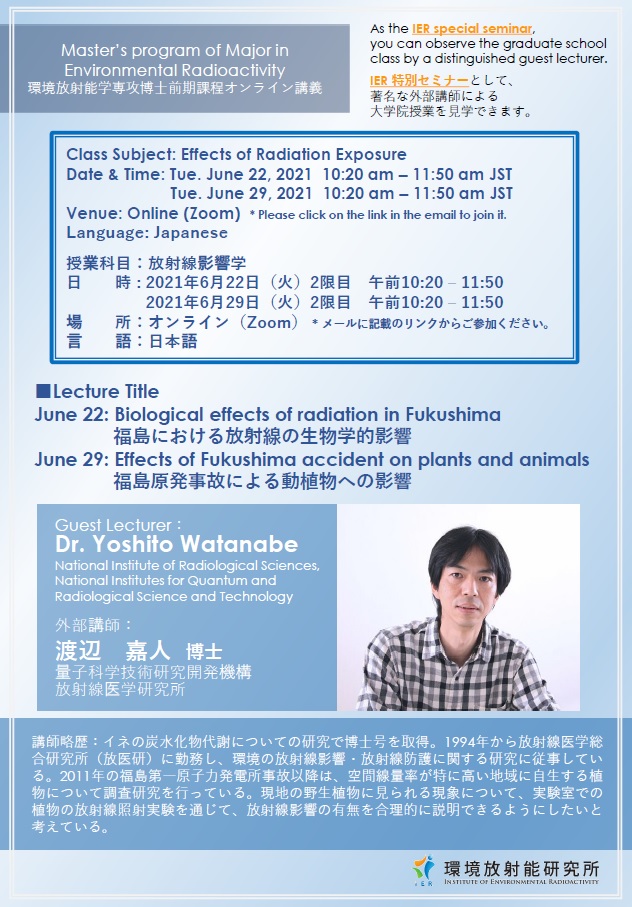June 22&29, 2021, we held an IER Special Seminar online <by Dr. WATANABE Yoshito>
Venue
Online (Zoom)
Guest Lecturer
Dr. Yoshito Watanabe, National Institute of Radiological Sciences, National Institutes for Quantum and Radiological Science and technology (QST NIRS)
In some of the classes of the Master’s Program of Major in Environmental Radioactivity, distinguished external researchers are invited as guest lecturers, and their classes are open to other faculty members on campus as “Special Seminars”.

◆Lecture 1◆ D&T: Mon. June 22, 2021, 10:20am‒11:50pm JST
Lecture Title: Biological effects of radiation in Fukushima
On June 22, the lecture on the subject “Effects of Radiation Exposure” by Dr. Yoshito Watanabe was attended by three IER graduate school master students, and several members of the IER and Fukushima University. Dr. Watanabe explained the basic mechanisms of radiation effects, types of radiation effects in humans, and radiosensitivity of different species. In particular, he elaborated on the dependence of radiosensitivity on chromosome volume and damage caused by continuous gamma irradiation. Further, Dr. Watanabe gave examples of radiation damages observed in plant and animal species in Chernobyl and Fukushima (Scots pine, red pine, Japanese fir, medaka fish etc.) and analyzed the dose dependencies of their chromosome aberration frequencies. The lecture participants talked about the radiation effects (deterministic or stochastic) on people, and about the doses and scenarios of acute irradiation of forests in Chernobyl zone.
◆Lecture 2◆ D&T: Tue. June 29, 2021, 10:20am‒11:50pm JST
Lecture Title: Effects of Fukushima accident on plants and animals
On June 29, the lecture on the subject “Effects of Radiation Exposure” by Dr. Yoshito Watanabe was attended by four IER graduate school master students, and several members of the IER and Fukushima University. In the introduction, Dr. Watanabe presented the basic concepts of the system of radiation protection of the Environment, such as RAPs (Reference Animals and Plants) and DCRL (Derived Consideration Reference Levels). Dr. Watanabe then assessed the risk of radiation by comparing the estimated dose rates on RAPs in terrestrial and marine ecosystems in Okuma during different periods after the Fukushima accidents with DCRL. The topics widely ranged from a comprehensive review of publications revealing radiation effects on wild animals and plants observed after the Fukushima accident, the effects of the Chernobyl nuclear accident on wildlife, problems in interpreting differences in radiation effects in the field and laboratory, progress in research on morphogenesis in Japanese fir, and to the importance of dosimetry and radiation exposure verification experiments. The participants discussed the radiosensitivity of animal species, including the possible effect of aging and other factors.
